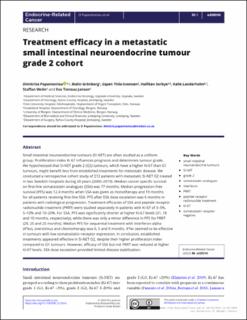| dc.description.abstract | Small intestinal neuroendocrine tumours (Si-NET) are often studied as a uniform group. Proliferation index Ki-67 influences prognosis and determines tumour grade. We hypothesized that Si-NET grade 2 (G2) tumours, which have a higher Ki-67 than G1 tumours, might benefit less from established treatments for metastatic disease. We conducted a retrospective cohort study of 212 patients with metastatic Si-NET G2 treated in two Swedish hospitals during 20 years (2000–2019). Median cancer-specific survival on first-line somatostatin analogues (SSA) was 77 months. Median progression-free survival (PFS) was 12.4 months when SSA was given as monotherapy and 19 months for all patients receiving first-line SSA. PFS after SSA dose escalation was 6 months in patients with radiological progression. Treatment efficacies of SSA and peptide receptor radionuclide treatment (PRRT) were studied separately in patients with Ki-67 of 3–5%, 5–10% and 10–20%. For SSA, PFS was significantly shorter at higher Ki-67 levels (31, 18 and 10 months, respectively), while there was only a minor difference in PFS for PRRT (29, 25 and 25 months). Median PFS for sequential treatment with interferon-alpha (IFNα), everolimus and chemotherapy was 6, 5 and 9 months. IFNα seemed to be effective in tumours with low somatostatin–receptor expression. In conclusion, established treatments appeared effective in Si-NET G2, despite their higher proliferation index compared to G1 tumours. However, efficacy of SSA but not PRRT was reduced at higher Ki-67 levels. SSA dose escalation provided limited disease stabilization. | en_US |

